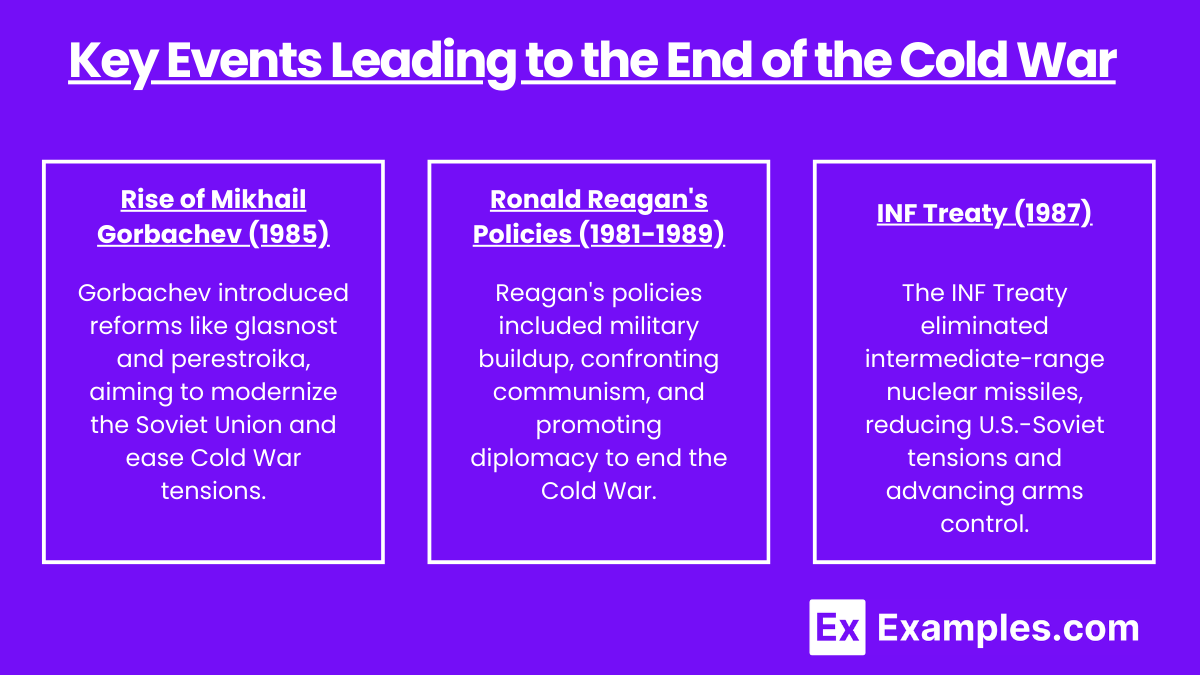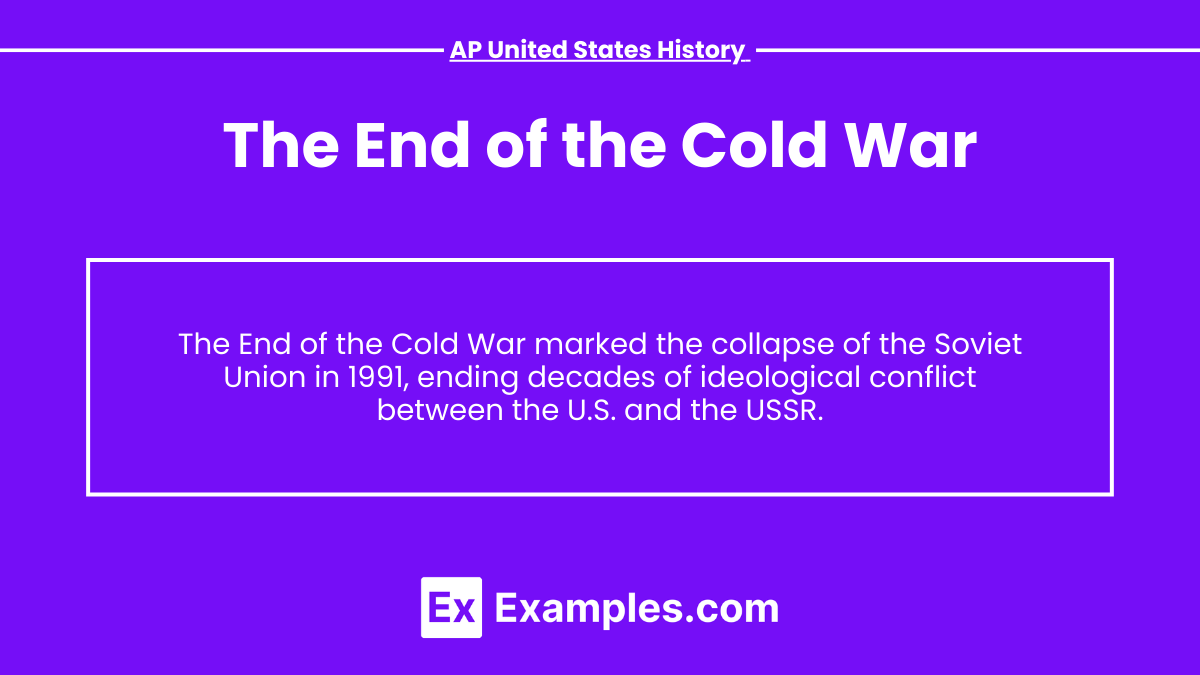The End of the Cold War marked a significant turning point in global history, ending decades of tension between the United States and the Soviet Union. Spanning from the 1940s to 1991, this period witnessed the collapse of the Soviet Union, leading to U.S. dominance. Understanding this era is crucial for AP United States History students studying modern geopolitics.
Learning Objectives
In studying The End of the Cold War, you should learn about the key events that led to the collapse of the Soviet Union, the role of U.S. foreign policy, and the influence of leaders like Reagan and Gorbachev. Understanding how these changes reshaped global politics and impacted U.S. dominance is essential for mastering this topic.
1. Background of the Cold War (1947-1991)

The Cold War began shortly after World War II, with rising tensions between the United States and the Soviet Union. The conflict wasn’t direct military confrontation but was characterized by:
- Ideological Differences: Democracy and capitalism (U.S.) vs. communism and authoritarianism (Soviet Union).
- Arms Race: Development of nuclear weapons and military technology.
- Proxy Wars: Conflicts like the Korean War, Vietnam War, and Soviet-Afghan War.
2. Key Events Leading to the End of the Cold War

The 1980s saw a series of events and policies that led to the decline of Soviet power and the eventual end of the Cold War:
A. Rise of Mikhail Gorbachev (1985)
Mikhail Gorbachev became the General Secretary of the Communist Party of the Soviet Union in 1985 and introduced major reforms:
- Perestroika: Economic restructuring to revive the Soviet economy by allowing some market-like reforms.
- Glasnost: Political openness that promoted transparency and free speech, challenging Soviet authoritarianism.
B. Ronald Reagan’s Policies (1981-1989)
President Ronald Reagan adopted a firm stance against the Soviet Union:
- Reagan Doctrine: Support for anti-communist movements around the world.
- Increased Defense Spending: Accelerated the arms race, which strained the Soviet economy.
- Strategic Defense Initiative (SDI): A proposed missile defense system that further pressured the Soviets to negotiate.
C. INF Treaty (1987)
The Intermediate-Range Nuclear Forces Treaty (INF), signed by Reagan and Gorbachev, eliminated nuclear and conventional ground-launched ballistic missiles with ranges of 500 to 5,500 kilometers. It was a significant step toward de-escalation.
3. Fall of the Berlin Wall (1989)

The fall of the Berlin Wall in 1989 symbolized the collapse of communist control in Eastern Europe:
- It marked the end of the division between East and West Germany.
- Led to the reunification of Germany in 1990.
- Demonstrated the weakening grip of the Soviet Union on its satellite states.
4. Collapse of the Soviet Union (1991)

Several factors contributed to the eventual dissolution of the Soviet Union in 1991:
- Economic Strain: Gorbachev’s reforms could not save the failing Soviet economy.
- Nationalism: Rising nationalist movements in Soviet republics like Lithuania, Latvia, and Estonia demanded independence.
- Failed Coup (1991): Hardline communists attempted a coup against Gorbachev, but it failed, weakening Soviet authority further.
In December 1991, Gorbachev resigned, and the Soviet Union officially dissolved, ending the Cold War.
5. Impact on the United States and the World

The End of the Cold War reshaped global politics in several ways:
A. U.S. Dominance
- The U.S. emerged as the world’s sole superpower, marking the beginning of a unipolar world.
- American influence grew in regions previously dominated by Soviet-backed governments.
B. Globalization
- The end of Cold War tensions allowed for increased global cooperation.
- International organizations like the United Nations and NATO expanded their influence.
- Economies became more interconnected as former communist countries transitioned to market economies.
C. End of Bipolarity
- The end of the Cold War ended the bipolar world system, where two superpowers competed for global dominance.
- It led to new challenges like regional conflicts, ethnic violence, and the rise of new global powers like China.
Examples
- Fall of the Berlin Wall (1989): Symbolized the collapse of communist control in Eastern Europe.
- Dissolution of the Soviet Union (1991): Official end of the Soviet Union, marking the Cold War’s conclusion.
- INF Treaty (1987): Eliminated intermediate-range nuclear missiles, easing U.S.-Soviet tensions.
- Revolutions in Eastern Europe (1989): Peaceful revolutions ousted communist regimes in countries like Poland and Hungary.
- German Reunification (1990): East and West Germany reunited, signaling the end of post-World War II divisions.
1. What event symbolized the beginning of the end of the Cold War?
A) Cuban Missile Crisis
B) Korean War
C) Fall of the Berlin Wall
D) Vietnam War
Answer: C) Fall of the Berlin Wall
Explanation: The 1989 fall of the Berlin Wall marked the collapse of communism in Eastern Europe, signaling Cold War’s decline.
2. Which U.S. President played a significant role in ending the Cold War?
A) John F. Kennedy
B) Lyndon B. Johnson
C) Ronald Reagan
D) Bill Clinton
Answer: C) Ronald Reagan
Explanation: Reagan’s policies, including military buildup and diplomacy, pressured the Soviet Union and helped bring about the Cold War’s end.
3. What was the primary goal of the INF Treaty?
A) Promote free trade
B) Eliminate nuclear missiles
C) Strengthen NATO
D) Reunify Germany
Answer: B) Eliminate nuclear missiles
Explanation: The INF Treaty (1987) removed intermediate-range nuclear missiles, reducing Cold War tensions and advancing arms control between superpowers.


